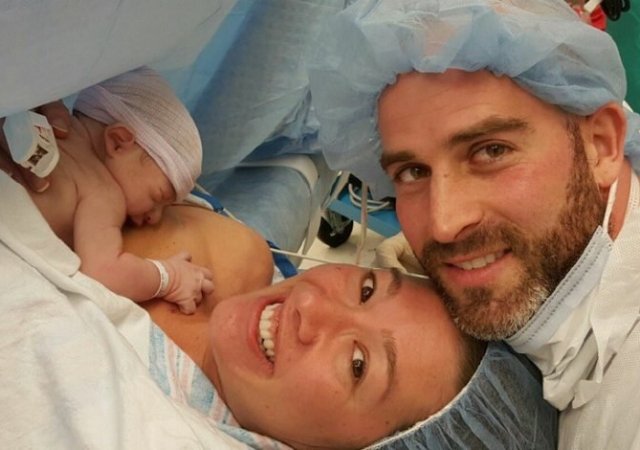The On-line Journal of Mary Esther Malloy
The Mindful Cesarean Birth Visualization
The Mindful Cesarean
If you are preparing for birth and thinking about a cesarean, there’s likely to be a good deal of emotional tacking, from excitement at meeting your baby to varying degrees of concern, fear, even grief. The Mindful Cesarean is about being present to what is. I hope the practices shared here help you to be present to your child’s birth, and the circumstances of this birth, while honoring—with compassion— your journey through, with all the emotional highs and lows.
Secondly, The Mindful Cesarean invites you to tap your body’s age-old knowledge of birth and link that inner blueprint to the experience of a birth supported by technology.

With a mindful approach to a cesarean, we are using the powerful mind to give the body a felt sense of birth, no matter the circumstances. It is not about a pretending you are having a vaginal birth, but bringing mindful awareness to your child’s birth, working towards presence at your child’s birth, and staying connected to the people who love and support you. Doing so lets your body (and your baby) know this isn’t just a surgery, this is a birth, a birth shaped by the particular challenges of surgery, but first and foremost, a birth.
Modern medicine has the goal of helping mothers and babies to survive. But nature wants more. Nature wants mothers and babies to thrive.
- Dr. Sarah Buckley, NYC 2014
When you give birth by cesarean, aspects of birth are skipped that involve hormones that have been part of birth since human time began – and for ages before. With a cesarean, especially a planned cesarean, mothers and babies can experience lowers levels of these important hormones. But just as thinking about toasty warm, just-baked muffins calls up a physiologic response in your body, a mindful approach to a cesarean activates your body’s birth signals, upping birth hormones that enhance your experience and support mother-baby bonding and breastfeeding.
When labor begins on its own timetable and unfolds without interference, and when mother and baby remain together after birth, the intricate and long-evolved dance of childbearing hormones – oxytocin, beta-endorphin, prolactin, and catacholamines – can best orchestrate what nature hopes for: mothers and babies who are healthy, happy, well-adjusted, breastfeeding and bonded.
But sometimes interventions are needed. Sometimes, to survive, the tools of surgery are essential.
The question I’ve asked as I’ve written The Mindful Cesarean is: when a baby must be born by cesarean, what can families do to optimize healthy birth hormones to best ensure that mothers and babies thrive? My goal is to help families who birth by cesarean to what nature intends: mothers and babies who are healthy, happy, well-adjusted, breastfeeding, and bonded, even when challenges arise.
I began writing The Mindful Cesarean as a simple birth visualization for women and their partners who may have to birth by cesarean. The project has grown into The Mindful Cesarean Toolkit for a Healthy Birth, a download-able booklet and series of recorded tracks, and this website.
With The Mindful Cesarean Toolkit for a Healthy Birth you receive:
- Cesarean as Birth
- The Mindful Cesarean Birth Visualization
- Pregnancy Relaxation
- Cesarean Quick Notes for Partners
- The Mindful Cesarean Birth Plan
- Sipping Broth for Recovery, and more
On this blog you will find:
- an extensive discussion of options to consider when preparing for the possibility of a cesarean
- a collection of inspiring birth stories
- important information about oxytocin-enriching ways to parent your child following a cesarean
- tips to avoid an unnecessary cesarean, and more

Mary Esther Malloy
I would like to thank everyone who contributed ideas and stories, especially Suzanne Chesney, co-leader of ICAN Manhattan who has been unflaggingly supportive. Suzanne has shared her own magnificent tale in these pages, as well as many helpful tips. I must also thank Dr. Pamela Morrison and Andrea Syms-Brown, both of whom share valuable information here as it relates to cesarean recovery (Dr. Pamela Morrison) and post-cesarean breastfeeding (Andrea Syms-Brown).
Jill Bergman, author of Hold Your Premie, kindly agreed to be interviewed all the way from South Africa on the important work she and her husband, Dr. Nils Bergman, are doing to raise the world’s awareness of the value of caring for newborns in skin to skin contact with their parents, especially following a cesarean (or “cesar” as Jill says). A warm thank you to the always-inspiring Jill and Nils Bergman of the Neuroscience for Improved Neonatal Outcomes Foundation (ninobirth.org).
Most of all, I must give a shout out to my many clients through the years who have taught me so much about birth, family-making, and the power of our stories.
The Mindful Cesarean would live only on paper if my husband, Jeremy Hopwood, hadn’t swooped in as producer, editor, and first-class cheerleader.
I wish you and your family all the best. I hope The Mindful Cesarean is of help.
Mary Esther Malloy, MA

